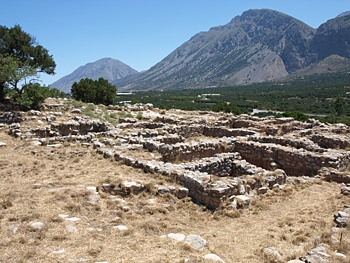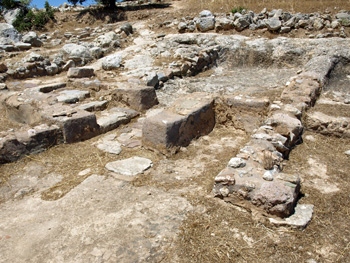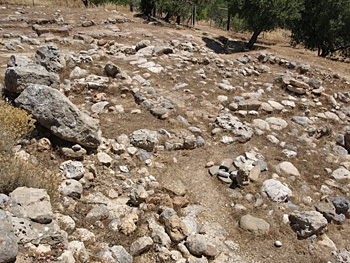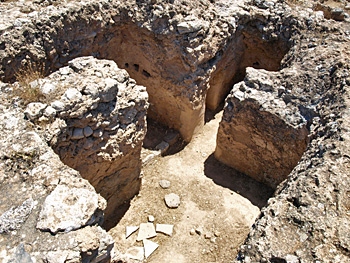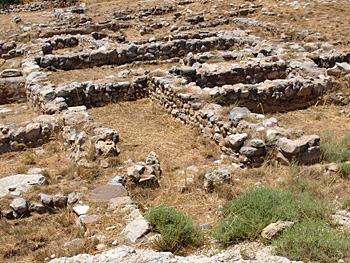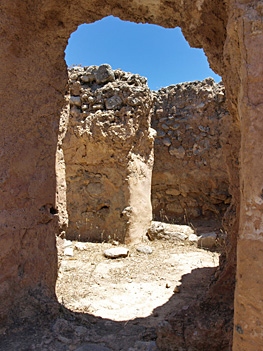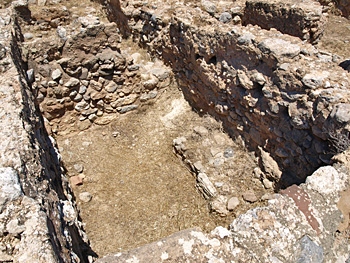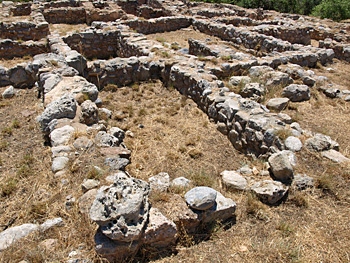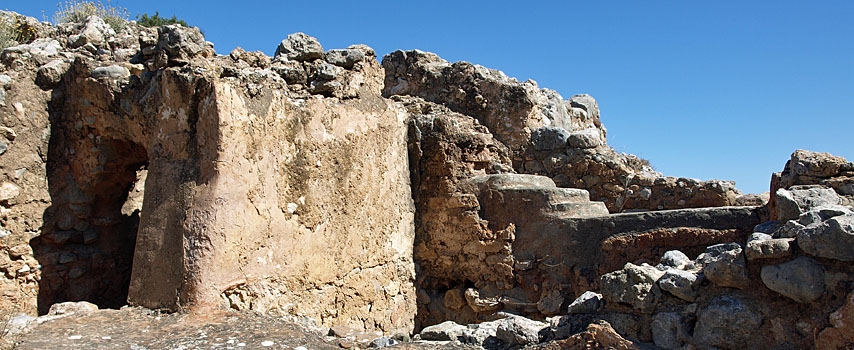
Location and excavations
Vasiliki is another important Early Minoan site which has been variously interpreted by different excavators. Originally excavated by the American R.B. Seager from 1903 to 1906, it was later excavated by N. Platon in 1953 and more recently and more thoroughly by A.A. Zois from 1970-82 and 1990 onwards.
The site is situated on a small hill at the northern end of the Ierapetra isthmus near the village of Vasiliki from which it takes its name. This isthmus is a short band of low-lying land some 11 kilometres in length stretching from the north coast of Crete in the bay of Mirabello to the Libyan sea to the south. The isthmus lies between the mountains of central Crete to the West and the mountains of Eastern Crete.
Just as Branigan interpreted Fournou Korifi as a unified settlement, possibly the house of a chieftain, so Vasiliki was also initially interpreted in a similar way by Seager. The "House on the Hill", as he named it, was considered to be a primitive form of Minoan Palace, a stepping stone along the road which would eventually lead to Knossos. Consequently it was considered to be the seat of some local "chieftain".
Subsequent excavations revealed that Vasiliki was not, in fact a primitive form of palace but the site of a number of building phases. Even the distinctive pottery found on the site and named Vasiliki Ware is not unique to this site, having been produced at several other sites and widely distributed to yet others.
Vasiliki was a typical Minoan village which, despite being destroyed by fire on a number of occasions, remained in use throughout most of the Minoan period. The first structures to be built were the Northern Houses and the South Building, the three rooms in dotted lines under the West House (see plan). They were constructed in EM IIA. These buldings were destroyed and new buildings went up on the site in EM IIB. In this early period (EM II) the houses are placed side by side, touching each other. This can be seen in the centre of the first picture (best in the large version) where four areas of almost equal size can be counted from right to left. Zois believes that this suggests an egalitarian society. Both the Red House and the West House date from EM IIB.
The Red House
The first to be built was the Red House in EM IIB1. The Red House, which takes its name from the colour of the red-painted lime plaster used on its walls, forms the basement of this part of the settlement, situated where the hill drops away to the south east.
It seems probable that the Red House was in fact two houses, one to the West, immediately adjacent to the West House and the other to the East, with adjoining walls to the south of the two buildings (see plan). Unlike other Early Minoan buildings horizontal timbers were used as part of the construction of the Red House. The red plaster was applied in several stages starting with a mix of clay, lime, straw and added pebbles. Then a thinner layer of fine clay was added and painted red.
The West House, immediately to the west of the Red House, was built in EM IIB2 and the remains are of the ground level. It was built as an annexe to the Red House and was used for both storage and for weaving as attested by the large number of loomweights found there.
It was also in this period that the paved courtyard was laid in what is now the centre of the site, to the northwest of the West House.
It was in the EM II phase of the settlement that the pottery now known as Vasiliki Ware was found. This represented a very distinctive development and the generally dark pottery is notable for the mottled effect of its finish. This seems to have been obtained by a deliberately irregular firing of the pottery. The first examples of Vasiliki Ware are to be found in East Crete in EM IIA but it is in the next period, EM IIB, that it becomes the dominant form among the fine wares throughout eastern and southern Crete. Among the most popular shapes are, according to Rutter, flat-bottomed jugs, teapots, dishes, spouted bowls and goblets. Vasiliki Ware was a very short-lived type and did not last long after EM IIB.
According to Zois, some Early Minoan III houses were found in the original excavations over a layer of Early Minoan IIB and thus constitute the best evidence to date for identifying EM III as a distinct historical phase. However, the EM III houses were not fully published. Unfortunately, at the beginning of the 20th Century, when many of the early excavators of Minoan Crete were at work, excavation techniques were not very sophisticated. Much evidence was not properly recorded or published and in many cases the evidence has been lost for ever.
The settlement continued to prosper through the Middle Minoan period, reaching its largest size in MM1A, though building continued as late as LM IA in the north east corner of the site. Little evidence exists after this period although a LM III tomb was discovered nearby. Its location is no longer known.
Vasiliki suffered three major destructions -- in Early Minoan IIA, Early Minoan IIB and Middle Minoan IIB, the last two by fire. However, the village was rebuilt again after each disaster and there is no evidence that the site was abandoned during this long period or that it was invaded by culturally different peoples.
Access
The site was until recently staffed in the summer but presumably the economic crisis in Greece has put paid to this. However, it is not difficult to obtain access. The path to the site can be found, signposted, a few hundred metres along the turning to Vasiliki village from the main road between the Gulf of Mirabello and Ierapetra.


